
In the Yellow Springs area we have a gardeners potluck that meets monthly and we have a chance to see various gardens and organic farms, and swap ideas. I've just started attending and wanted to share some of the things I saw at the last meeting.
Our friends Jenny Haack and Rob Content moved here a few years and ago and bought a small (approximately 6 acres) farm property just outside Yellow Springs. Jenny has been trained in permaculture so they started a garden that utilized the garden spaces that were already on the property. Then they worked with Andrew Maneri, a local organic farmer, to develop part of the property as a working CSA (Community Supported Agriculture) farm.
Rob and Jenny have been through many twists and turns in their experience with this project and I think that is as important to their story as the food and the farm are. Rob has to work long distance in Washington D.C. in order to pay the bills, so Jenny does most of the work on the farm right now with Rob helping when he can. They wanted Andrew and his wife to be able to live on the farm with them, so they built a yert with a lot of help with people in the community. However, the zoning laws make it difficult for someone to live in the yert year around, so it can't be a permanent residence. Of course they didn't know that until the yert was built, so - what a learning process! This year, because of so many changes in their lives Jenny hasn't done a lot with the garden, but she hosted our potluck a few weeks ago and she is hosting a permaculture workshop in a few weeks (which I'm planning to attend!).
I think it's important to note that we may set out on a path that we think is very important and that we are committed to - eating local food, starting a garden, living a more energy efficient lifestyle - but there are sometimes obstacles, illnesses, job losses, aging and other problems along the way that make the path different from what we thought it would be. It seems important to take note of those things because they are really a part of the path and not something separate from it. I think we have to embrace those things along the way. The yert is a beautiful structure that can be used in many ways and Jenny's gardens are productive with berries, apples, and many edible perennials even if they aren't pristine annual vegetable beds right now.


There is a woman who is keeping bees on the farm, so we had a chance to get up close to the bees. It's amazing to watch them. We buy honey in 50 lb. buckets from a local farm just outside Yellow Springs and apparently their bees aren't producing very much honey this year. I just picked up a 63 lb. bucket this morning at the farmer's market this morning,so that should last for awhile, although it's amazing how quickly we go through it.

We also had a chance to see the "no-till" style of farming that Andrew practices. He puts in beds the same way we do by laying out newspaper or cardboard and piling manure on top of it. Then he plants his vegetables, but doesn't till all around them, so you will see in the photo that there is squash growing in the midst of a lot of clover in the field. He farms this way because it doesn't disturb the ecosystem as much, it preserves the soil and the root structures of the native plants, and the native plants are good companions for his annual vegetables. At least the way I understand it!

One of the things that has come out of this gardener's network is a series of community gardens in which various parks throughout the village are being used for gardening. People can sign up for a plot and share the garden space with others in their neighborhood. One of the community gardens is right across the street from us so we see many people working throughout the week in their gardens. Also our neighbors on both sides have gardens so we talk to them mostly when we are all in the backyard weeding, watering, harvesting, and mulching. I think there is a huge network of people everywhere who are starting to tune into food production and who are learning all over again how to grow, harvest and preserve food. Tomorrow we are going to meet at the home of an older couple who move to Yellow Springs recently and built an energy efficient house with solar and geothermal. It should be an interesting gathering!
Community Garden across the street



































